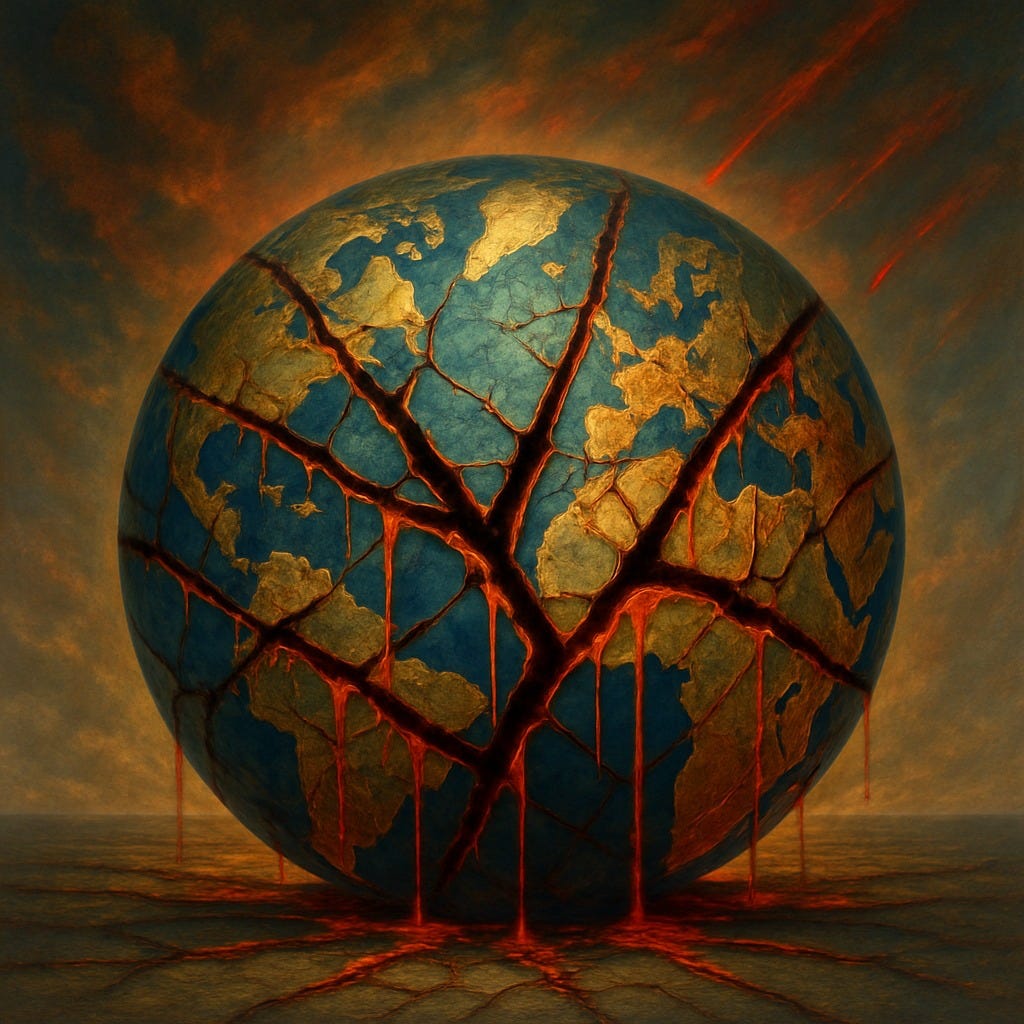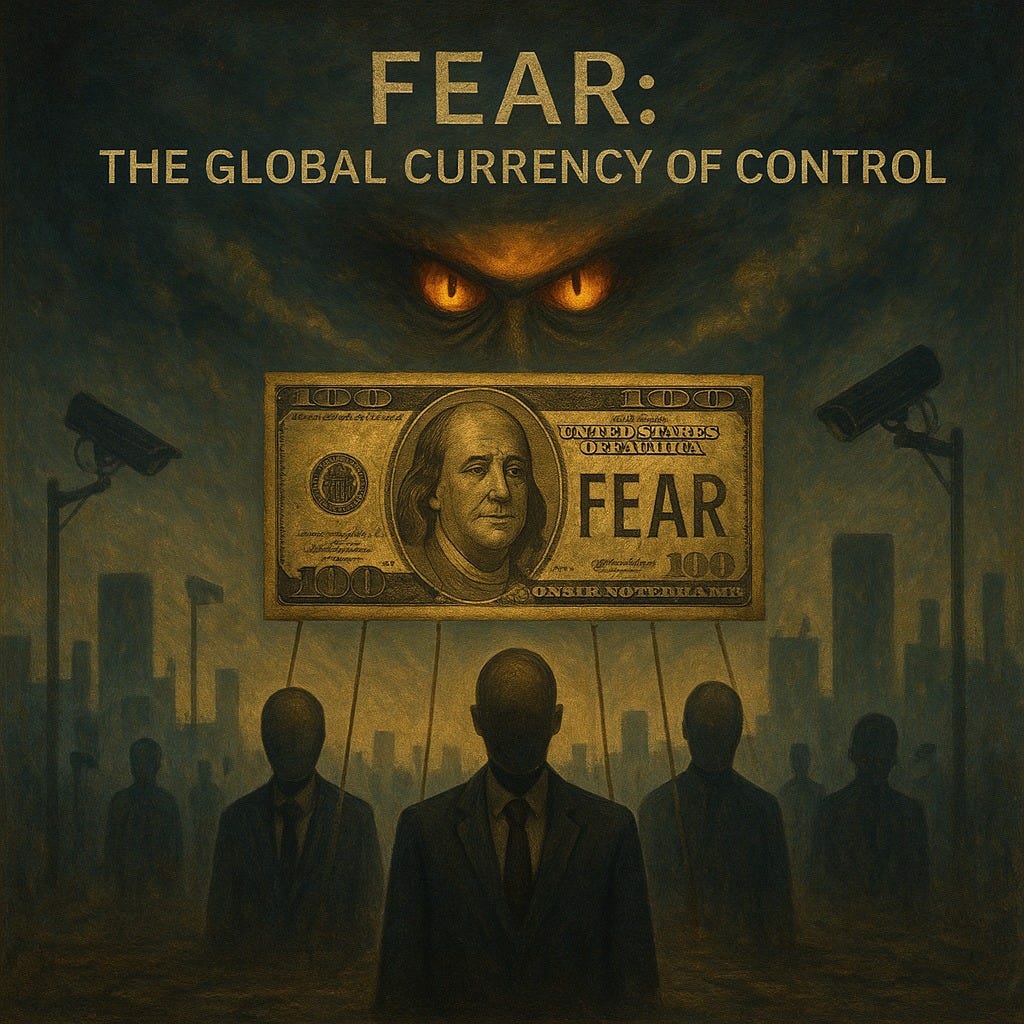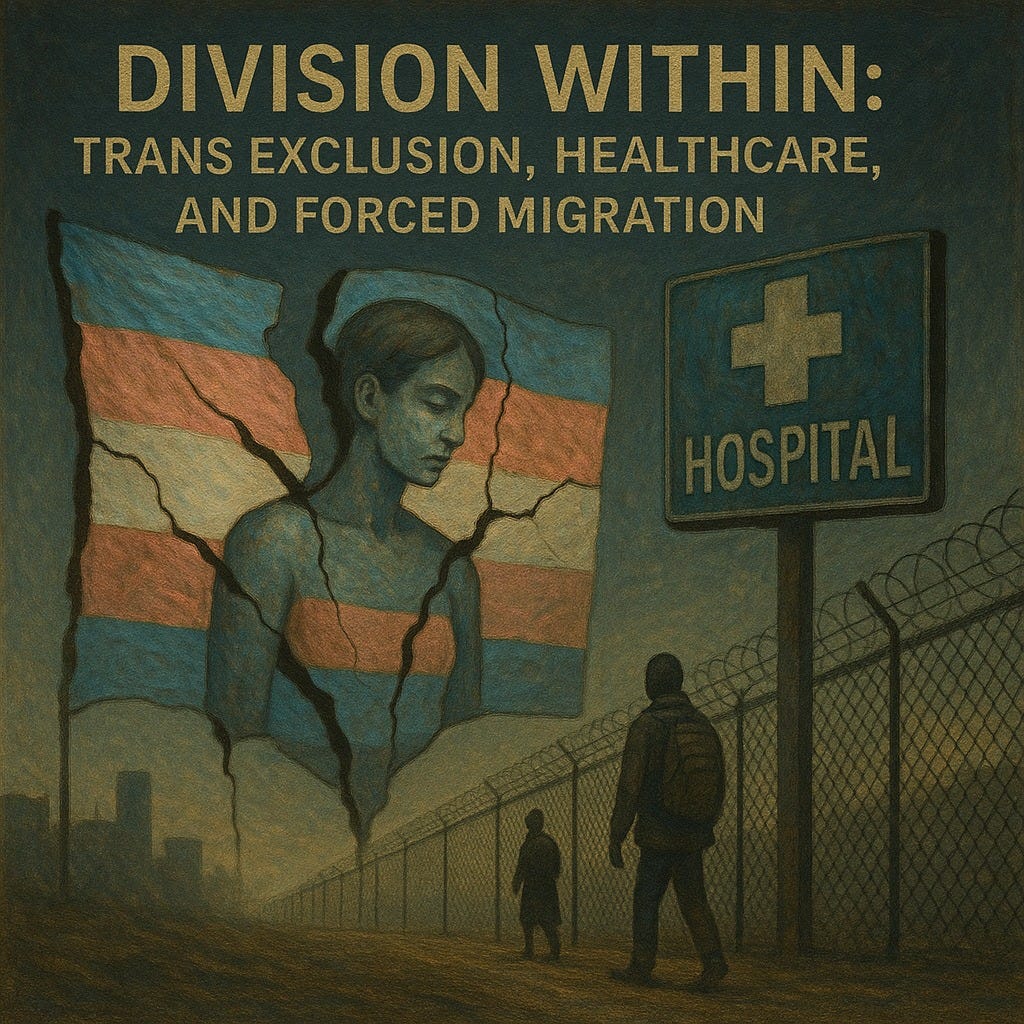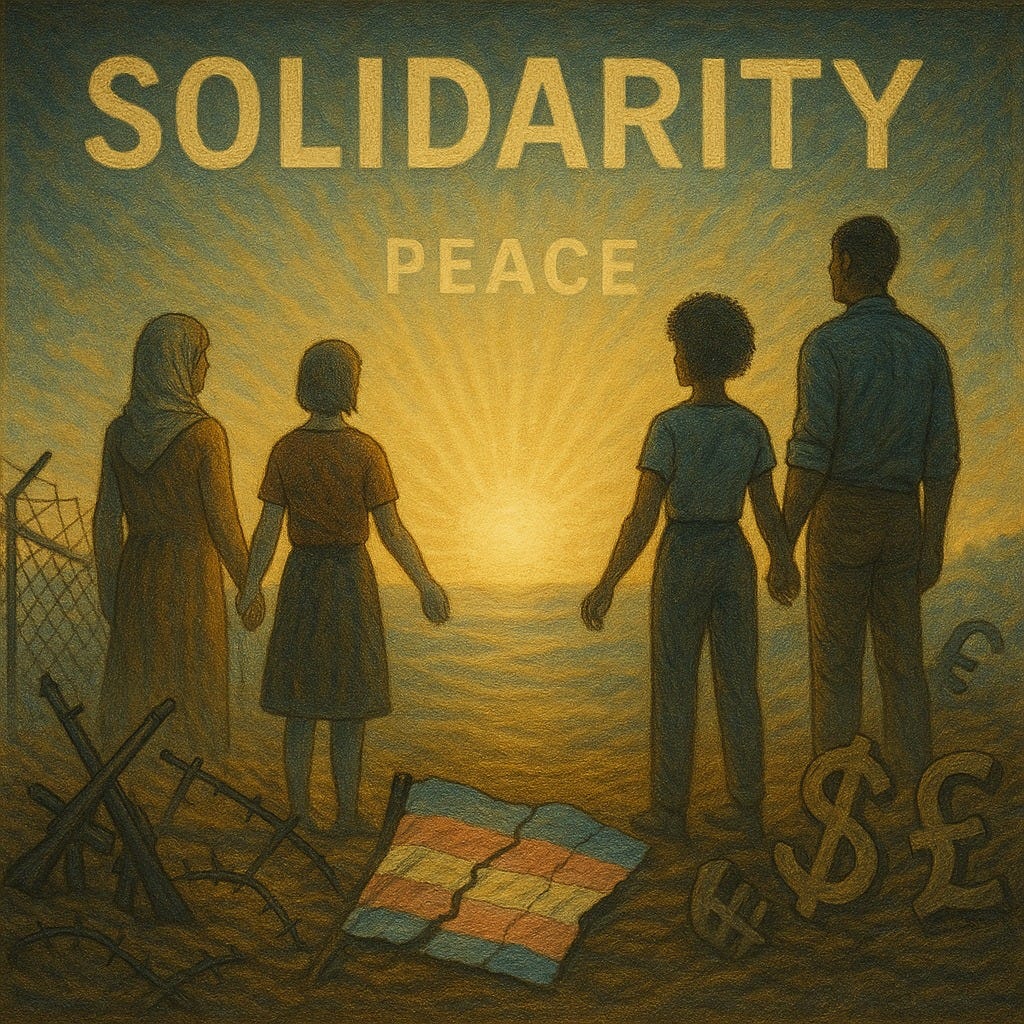The Cauldron of Fear
From Gaza to Westminster, how division is engineered to fracture solidarity and feed the machinery of crisis.
Introduction
"I have a dream that one day this nation will rise up and live out the true meaning of its creed: ‘We hold these truths to be self-evident, that all men are created equal.” (King, 1963)
I dream of peace—not for myself alone, but for all humanity. I dream of a world without hate, where our differences are not feared but celebrated, where diversity is the song we sing together. Yet when I look upon the world as it is, I see division: Gaza in flames, Ukraine in ruins, Islamophobia rising like a shadow, the cruelty of austerity grinding down lives in Britain, asylum seekers turned into enemies, transgender people demonised for daring to exist, and the far right rising again in Europe and the United States.
Although these struggles are often spoken of as though they are separate or merely local, I know they are bound together. They are the fractures of one broken reality, the bitter fruit of the same tree of hate, left to simmer until they boil over, spilling across the world. Different in form yet joined in substance, they are not many fires but one great blaze: not many wounds, but one deep cut.
The politics of division and fear cannot be the final word. It corrodes trust, paralyses solidarity, and enriches only those who profit from chaos. But there is another way—there must be another way. For I dream still of a peace that belongs to all of us: a peace born of justice, carried by compassion, and made real by our refusal to hate.
This essay contends that the crises we face—wars abroad, culture wars at home, and the relentless manufacture of fear—are interconnected strategies of domination. To resist them requires recognising division as a political technology and reclaiming solidarity as the basis of a more just and peaceful world.
Division: A Political Technology of Fear and Control
When I describe division as a “technology,” I mean it in the sense Michel Foucault used the term: not merely as machines or devices, but as structured methods of governance—techniques for managing populations (Foucault, 1991). Division works like surveillance or bureaucracy. It is a tool of power. It organises who belongs and who does not, who is safe and who is dangerous, who is worthy and who is expendable.
The ancient maxim divide et impera—divide and rule—has never lost its relevance. Empires from Rome to Britain thrived by setting subject peoples against one another, ensuring they could not unite against their rulers. In our time, the tools of division have changed but the principle remains. Today it is less about manipulating provinces than about fragmenting public consciousness.
Media systems amplify this fragmentation. Chomsky and Herman (1988) argued in Manufacturing Consent that mass media filter and shape debate, producing consent for policies that might otherwise be rejected. Endless focus on cultural flashpoints—whether debates over pronouns, headscarves, or statues—channels public rage into narrow disputes while leaving the deeper structures of militarisation and economic exploitation intact.
Antonio Gramsci observed that ruling classes maintain power not only through coercion but through “hegemony”—a set of cultural and ideological norms that make the existing order appear natural (Gramsci, 1971). In this sense, polarising debates serve to uphold hegemony: they appear radical, but they keep anger circumscribed within safe boundaries. People are encouraged to fight their neighbour, not their government; to blame asylum seekers or trans teenagers, not arms manufacturers or tax-dodging billionaires.
As James Baldwin warned, “The most dangerous creation of any society is the man who has nothing to lose” (Baldwin, 1961, p.10). The role of division is to prevent that danger: to ensure discontent is redirected away from systemic critique and into manageable rivalries.
At the heart of division lies fear. Fear is what turns neighbours into enemies, difference into danger, and despair into obedience. It is fear that circulates across borders more powerfully than money, becoming the global currency of control.
Fear: The Global Currency of Control
If division is the technology, fear is its fuel. Modern societies are governed less by reasoned debate than by a rolling crisis machine: fear of migrants, fear of terrorism, fear of pandemics, fear of the “Other.” Each fear, though often exaggerated or distorted, becomes the justification for extraordinary measures.
The “war on terror” exemplified this dynamic. After 9/11, Western governments fused real threats with imagined ones, cultivating a climate in which mass surveillance, extrajudicial drone strikes, and indefinite detention could be normalised (Kundnani, 2014). Similarly, fears about migration vastly exceed actual risks. Studies show asylum seekers commit crimes at lower rates than sensationalist media coverage suggests (Legewie, 2013). Yet the image of the “dangerous migrant” persists—because it is politically useful.
In each case, the mechanism is the same: insecurity is manufactured in order to expand state power. Hannah Arendt (1963) observed that totalitarian systems depend on cultivating perpetual instability, for “the masses’ escape from reality is essential for the regime’s survival” (p.307). Our present, though not fully totalitarian, resonates with her insight. Fear corrodes solidarity and makes people cling to authority, even when that authority itself produces the very conditions of danger.
For those of us who yearn for peace, living in such an atmosphere is exhausting. It becomes difficult even to imagine a world not organised around fear. Yet this act of imagination is precisely what must be defended—and nowhere is this clearer than in the politics of migration, where division and fear converge most starkly.
Division and Displacement: Asylum Seekers, Migrants, and Manufactured Crises
Nowhere is the “technology of division” more visible than in the politics of asylum and migration. Wars—whether manufactured or “real”—drive millions from their homes, and those displaced then become the subjects of fresh political battles in the countries where they seek refuge. They are simultaneously produced by global systems of war and exploited as symbols of fear within those same systems.
Armed conflicts have long been engines of displacement. The wars in Iraq and Afghanistan, justified in the West as defensive or humanitarian, uprooted millions. Yet the very governments that bombed Baghdad or Kandahar later portrayed the refugees of those wars as potential terrorists or welfare burdens. This double standard reveals the function of division: responsibility is obscured while resentment is inflamed. Stephen Castles and Mark Miller (2009) describe this as “the age of migration,” in which globalisation and conflict together produce unprecedented human mobility. Saskia Sassen (2014) extends this, describing migration as an “expulsion”—a forced uprooting caused not only by war but also by the economic devastation that follows neoliberal restructuring and resource extraction. Migration, in other words, is not random. It is structured by the very powers who later demonise migrants.
The label “refugee” itself is also politically constructed. Roger Zetter (2007) shows how states constantly redefine categories of migrants to suit their interests, drawing lines between “genuine” asylum seekers and “bogus” economic migrants. Yet in reality, these lines blur: wars destroy not only lives but economies, forcing people to flee both bombs and poverty. Declaring one form of flight legitimate and another illegitimate is to deny the structural violence that links them. Meanwhile, receiving states quietly benefit from these very displacements. Migrants provide cheap labour in agriculture, construction, and care work, while also serving as scapegoats for austerity. Public anger at cuts to healthcare or housing is redirected toward migrants rather than the policies that caused the cuts. Zygmunt Bauman (2004) describes such displaced people as “wasted lives”—not because they lack value, but because the system treats them as disposable. Their suffering sustains global profits even as their humanity is denied.
The connections run deeper still. Conflicts that produce refugees often enrich those who fuel them: arms sales, reconstruction contracts, and access to resources all generate economic benefits for powerful states. The cycle is vicious: war creates refugees; refugees create political division; division justifies further militarisation. In this sense, displacement itself becomes part of the economy of endless crisis. Tendayi Achiume (2019) argues that migration should be seen as “decolonisation”: the return of people to the centres of power that once exploited their lands. Yet instead of acknowledging this history, Western states militarise their borders, transforming victims of conflict into symbols of threat. Once again, division performs its function—obscuring responsibility, inflaming fear, and consolidating power.
Division Within: Trans Exclusion, Healthcare, and Forced Migration
Division does not only determine who crosses borders; it also dictates who is denied the right to remain within their own. Governments, responding to the faux fears stoked by powerful lobbies, often weaponise health, welfare, and identity policy to push vulnerable communities into precarity. In the UK, for instance, recent statements by health ministers about restricting access to gender-affirming care show how trans people are excluded not only symbolically but materially (Stonewall, 2021; ILGA-Europe, 2023).
Denying healthcare is never neutral. It coerces people into impossible choices: seeking costly private treatment, travelling abroad for basic medical services, or leaving unsafe labour markets in search of dignity elsewhere. In this sense, anti-trans politics operate within the same machinery that produces asylum seekers. Both are outcomes of manufactured fears channelled into policy; both serve to divide populations while shielding elites from accountability; and both reproduce the logic of dehumanisation that history shows can end in atrocity.
As Judith Butler (2004) reminds us, our lives are marked by shared vulnerability. To deny the humanity of another is to deny the relational fabric that sustains us all. A feminism that excludes trans women, disguised as “gender critical” ideology, is therefore not feminism at all, but complicity in a wider politics of hate.
History teaches us that atrocities rarely begin with bullets. They begin with words. In Nazi Germany, Jews were vilified as corruptors; in Rwanda, Tutsis were labelled “cockroaches.” Today, trans women are painted as predators or impostors. The contexts differ, but the underlying logic of dehumanisation is chillingly familiar.
This logic has consequences that extend beyond trans lives alone. In times of armed conflict, women’s bodies have often been weaponised—through rape, forced pregnancy, or humiliation. The dehumanisation of any vulnerable group, including trans women, normalises the idea that some bodies are expendable. TERF rhetoric, by denying the humanity of trans women, indirectly reinforces the very logics that enable crimes against women in war.
We may not fully understand the trans experience, but that does not absolve us of responsibility. What is never acceptable is to vilify those whose lives are already precarious. To do so is to keep alive the hatreds that, in other forms, have justified pogroms, genocides, and wars.
The Economics of Endless Crisis: From Gaza to Westminster, Towards Connection
Behind the theatre of division and fear lies a blunt truth: crisis is profitable. The military–industrial complex thrives on perpetual insecurity. In 2022, global arms sales surpassed $112 billion (SIPRI, 2023). Companies such as Lockheed Martin and BAE Systems depend not on peace but on war, not on stability but on endless conflict.
President Dwight D. Eisenhower, himself a career soldier, warned in 1961 of the “unwarranted influence” of the military–industrial complex, cautioning that “the potential for the disastrous rise of misplaced power exists and will persist” (Eisenhower, 1961, p.3). His warning was prescient. Today, the wars in Ukraine and Gaza justify new waves of rearmament, while austerity policies at home strip health systems, welfare provision, and education budgets. The machinery of crisis feeds itself: external wars legitimise internal cuts, and both enrich those who profit from instability.
This economy of crisis extends beyond war. Climate change too is framed in militarised terms: “climate refugees,” “border security,” “resource wars.” Instead of confronting systemic inequality and overconsumption, governments prepare to police its victims. As Simon Dalby (2013) notes, discourses of “climate security” often do more to protect elite power than to address ecological breakdown. Once again, the framing of fear diverts attention from structural causes while reinforcing militarised solutions. Every cut to healthcare, every hospital closure, every underfunded classroom is a reminder that governments have chosen to value war over life. This is not only economic austerity but moral austerity: human flourishing is sacrificed so that tanks and missiles may flourish instead.
It is tempting to see Gaza as an isolated tragedy, or British austerity as a purely domestic policy. But these struggles are linked by a common logic. Israel’s bombardment of Gaza is sustained not only by domestic politics but by billions in U.S. military aid, part of a regional strategy of dominance (Thrall & Pressman, 2023). Britain’s austerity is tied to global neoliberal orthodoxy, enforced by financial markets and international institutions. Russia’s war in Ukraine reverberates in NATO arms contracts and European energy markets. Martin Luther King Jr. reminded us that “injustice anywhere is a threat to justice everywhere” (King, 1963, p.1). The struggles of a refugee in Calais, a nurse in London, a mother in Gaza, a trans teenager in Texas—these are not separate struggles. They are variations on a theme: the erosion of dignity in the service of profit and power.
For me, this recognition is not abstract. My father’s wartime experiences taught me that war is not an idea but a lived reality. It is hunger, rubble, displacement, grief. It is ordinary people caught in the games of elites. To see echoes of that suffering today is to understand that history has not ended; its cruelties repeat in new forms.
If fragmentation fuels authoritarianism, then solidarity is its antidote. Étienne Balibar (2004) speaks of “equaliberty”—the intertwined pursuit of equality and freedom. We cannot pursue freedom without equality, nor equality without freedom. To do so is to leave space for manipulation. Audre Lorde (1984) captured this insight in her famous declaration: “There is no such thing as a single-issue struggle because we do not live single-issue lives” (p.138). The task, then, is to weave together our fragmented struggles into a politics of connection.
For me, choosing peace is not naïve but radical. It is to resist the cynicism that says division is inevitable. It is to affirm that solidarity is possible, that a world without hate is not a dream but a necessity. It is to believe, even in the face of chaos, that humanity can yet choose life over destruction.
Conclusion
The chaos we inhabit—wars abroad, culture wars at home, endless cycles of fear and austerity—may feel overwhelming. Yet when we trace their connections, a pattern emerges. Fragmentation is not natural; it is manufactured. Fear is not accidental; it is cultivated. And behind it all lies a system that thrives on division, insecurity, and destruction.
To resist this system is to insist on peace: not a passive peace defined by the absence of war, but an active peace made real through justice, solidarity, and care. It is to refuse the logics of scapegoating in all their forms—from the demonisation of asylum seekers to the vilification of trans people; from austerity that punishes the poor to bombardments that devastate civilians in Gaza. It is to declare, in the face of every politics of fear: we will not be divided. We will not be made afraid. We will not give our humanity away.
But resistance is only the beginning. The task before us is also to imagine, and to build, a different world. A world where diversity is cherished, where vulnerability is met with care, where solidarity crosses borders of nation, race, gender, and faith. A world where power is measured not by the weapons we stockpile but by the dignity we extend to one another.
This is not a naïve dream. It is, rather, the most urgent political project of our time. For if division is the technology of domination, then connection must be the technology of liberation. To dream of peace is not to look away from violence, but to confront it with the insistence that another future is possible—and to act, together, until that future is real.
Bibliography
Achiume, T.E., 2019. Migration as decolonization. Stanford Law Review, 71, pp.1509–1574.
Arendt, H., 1963. The origins of totalitarianism. Cleveland: World Publishing Company.
Balibar, É., 2004. We, the people of Europe? Reflections on transnational citizenship. Princeton: Princeton University Press.
Baldwin, J., 1961. Nobody knows my name: More notes of a native son. New York: Dial Press.
Bauman, Z., 2004. Wasted lives: Modernity and its outcasts. Cambridge: Polity Press.
Butler, J., 2004. Undoing gender. New York: Routledge.
Castles, S. and Miller, M.J., 2009. The age of migration: International population movements in the modern world. 4th ed. Basingstoke: Palgrave Macmillan.
Chomsky, N. and Herman, E., 1988. Manufacturing consent: The political economy of the mass media. New York: Pantheon.
Dalby, S., 2013. Climate change and security: Agency and the local–global nexus. Annual Review of Environment and Resources, 38, pp.347–363.
Eisenhower, D.D., 1961. Farewell address. Washington, DC: Government Printing Office.
Foucault, M., 1991. Discipline and punish: The birth of the prison. London: Penguin.
Gramsci, A., 1971. Selections from the prison notebooks. New York: International Publishers.
ILGA-Europe, 2023. Annual review of the human rights situation of LGBTI people in Europe and Central Asia. Brussels: ILGA.
King, M.L., 1963. Letter from Birmingham Jail. Birmingham, AL.
Kundnani, A., 2014. The Muslims are coming! Islamophobia, extremism, and the domestic war on terror. London: Verso.
Legewie, J., 2013. Terrorist events and attitudes toward immigrants: A natural experiment. American Journal of Sociology, 118(5), pp.1199–1245.
Lorde, A., 1984. Sister outsider: Essays and speeches. Berkeley: Crossing Press.
Pearce, R., 2018. Understanding trans health: Discourse, power and possibility. Bristol: Policy Press.
Sassen, S., 2014. Expulsions: Brutality and complexity in the global economy. Cambridge, MA: Harvard University Press.
Shires, D.A. and Jaffee, K.D., 2015. Factors associated with health care discrimination experiences among a national sample of female-to-male transgender individuals. Health & Social Work, 40(2), pp.134–141.
SIPRI, 2023. Trends in international arms transfers, 2022. Stockholm: Stockholm International Peace Research Institute.
Stonewall, 2021. Trans report: Healthcare access in the UK. London: Stonewall.
Thrall, N. and Pressman, J., 2023. The Gaza wars: Strategic logic and historical tragedy. Foreign Affairs, 102(4).
Zetter, R., 2007. More labels, fewer refugees: Remaking the refugee label in an era of globalization. Journal of Refugee Studies, 20(2), pp.172–192.
Suggested Reading
Arendt, H., 1958. The human condition. Chicago: University of Chicago Press.
Butler, J., 2020. The force of nonviolence: An ethico-political bind. London: Verso.
Fanon, F., 1961. The wretched of the earth. New York: Grove Press.
Klein, N., 2007. The shock doctrine: The rise of disaster capitalism. New York: Metropolitan Books.
Mbembe, A., 2019. Necropolitics. Durham: Duke University Press.
Žižek, S., 2008. Violence: Six sideways reflections. London: Profile Books.




